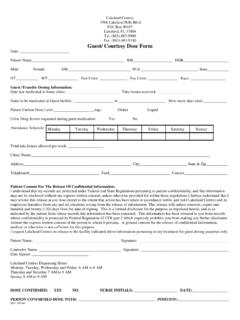Transcription of Fire Codes Technical Bulletin 370 - Halogen Valve
1 -1- T. B. , 1/13 fire Codes Technical Bulletin This Bulletin provides consulting engineers and facility managers overview of the two fire Codes in use as of 2012 and an interpretation of their applicability regarding the Halogen Valve System s Terminator and Eclipse emergency shutoff systems for toxic gas cylinders and ton containers.
2 Background Every state and county has regulations that provide the standards for the construction of residential, commercial and industrial buildings in their jurisdiction. The regulations involve electrical, plumbing, mechanical and fire prevention Codes that all designs and construction must meet. In the preparation of these regulations, the legislative bodies writing the regulations use guide Codes that are produced by model code organizations . These Codes have the force of law when adopted. The governing body can adopt one of the two available model Codes or modify the code to meet local situations.
3 Of primary interest to those using chlorine, sulfur dioxide, ammonia and other compressed gases are the Building code and the fire code . These two Codes provide standards and criteria for the storage and use of toxic or hazardous materials. Chlorine meets the toxic standard while sulfur dioxide and ammonia have less hazardous classifications. The two Codes are reissued every three years with supplements published during the intermediate years. Local fire Chiefs or fire Marshals have the final say on installations in their region and have been known to provide variances depending on the local needs.
4 Therefore, all local officials should always be consulted regarding the installation of new chlorine, sulfur dioxide and ammonia facilities or revisions to existing facilities. History fire Codes were expanded in the 1980s to meet the increased use of a wide variety of toxic, highly toxic and hazardous gases. This is particularly apparent in those industries using highly toxic gases such as the semi-conductor industry. There were three (3) fire Codes developed and issued at that time. They were the Uniform fire code (UFC), the Standard fire code (SFC) and the National fire code (NFC).
5 By 2001, there was a shuffle in the Model code organizations. The UFC continued to be produced but combined with the National fire Protection Association (NFPA). The SFC and the NFC combined with the International code Council (ICC) to produce the International fire code (IFC). Thus there are two Codes available today The UFC and the IFC and these Codes as well as the originals differed in their requirements. Original Codes and their requirements included the following: 1. The Uniform fire code (UFC) was originally published by the International fire code Institute of Whittier, California and produced by the Western fire Chiefs Association, Temecula, California.
6 The UFC has been adopted by and is used primarily in states west of the Mississippi River. The UFC had rigid regulations regarding the use of chlorine. Referred to as Article 80"; the UFC required exhausted enclosures and treatment systems (scrubbers) when more than one cylinder was stored or used. In 1994 revisions, exempt amounts of 150-pound cylinders in storage were allowed when sprinklers were included and the enclosure walls had a one-hour fire rating (Table 1). By 2003 UFC allowed 150 lb. cylinders and Ton Containers to be excluded from using scrubbers when Automatic Valve Shutoff Systems were employed.
7 2. The Standard fire code (SFC) was published by the Southern Building code Congress International of Birmingham, Alabama and produced by the Southeastern fire Chiefs Association and the Southwestern fire Chiefs Association. The SFC has been adopted by and is used primarily in states east of the Mississippi River and south of the Mason-Dixon Line. The SFC required treatment systems as identified in the UFC but allowed the use of containment methods using the Chlorine Institute (CI) Emergency Kits A (for 150 pound cylinders) and B (for ton containers) in lieu of scrubbers.
8 The SFC also allowed for storage in sprinkler areas with walls of a one-hour fire rating. (Table 1) The 2003 IFC allowed 150 lb. cylinders and ton containers to be excluded from using scrubbers when Automatic Valve Shutoff Systems were employed 3. The National fire code (NFC) was published and produced by the Building Officials and code Administrators of America (BOCA). The NFC has been adopted by and is used primarily in states east of the Mississippi River and north of the Mason-Dixon Line. The NFC required treatment systems but allowed the use of containment systems including the CI Emergency Kits as well as cylinder coffins.
9 The NFC also allowed for storage in sprinkler areas with walls of a one-hour fire rating (Table 1). The 2003 the IFC allowed 150 lb. cylinders and ton containers to be excluded from using scrubbers when Automatic Valve Shutoff Systems are 1 MAQ Amounts of Hazardous Gases per Control Area Summary of Uniform fire code , 2012 Edition, Chapter 63, Table Maximum Quantities per Control Area storage and use combined Material Unsprinklered No Gas Cabinet Liquified / NonLiq. Unsprinklered Gas Cabinet Liquified / NonLiq. Sprinklered No Gas Cabinet Liquified / NonLiq.
10 Sprinklered Gas Cabinet Liquified / NonLiq. Toxics 150 lb. / 810 ft 300 lb. / 1,620 ft 300 lb. / 1,620 ft 600 lb. / 3,240 ft -2- T. B. , 1/13 fire Codes (Cont ) Technical Bulletin Note: Although the above was abstracted from the 2012 UFC is also applicable to the IFC and the NFPA.









